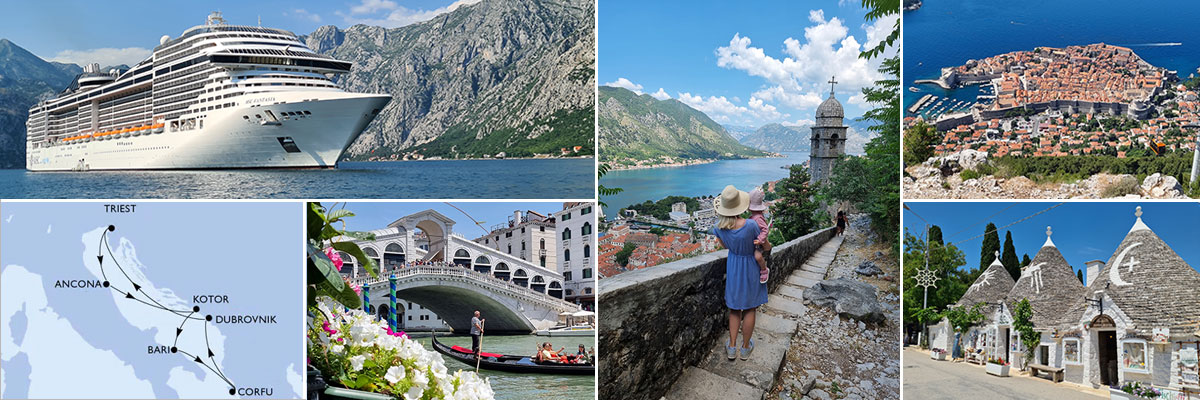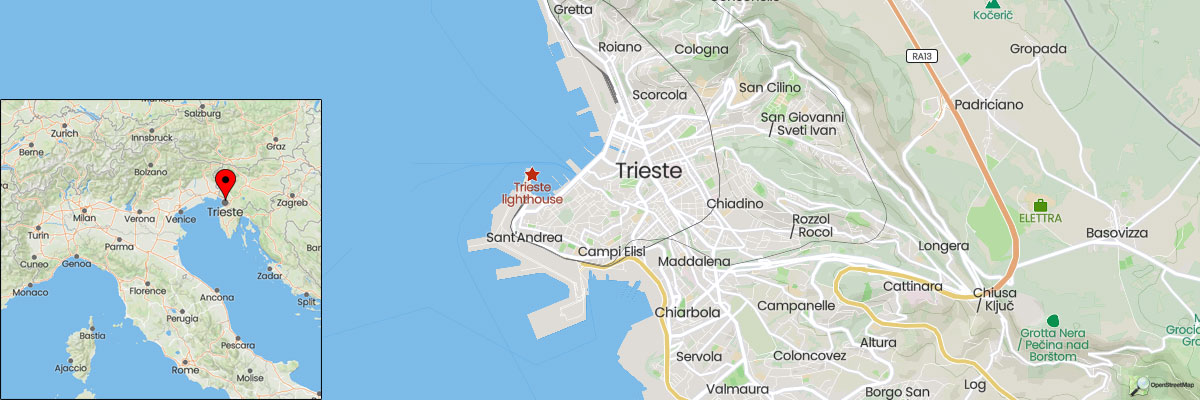The city of Trieste in northeastern Italy was the starting point of our 8-day cruise with MSC Cruises through the Adriatic Sea. We only had a half day to explore the city. However, since the cruise terminal is super centrally located near the city center, we were able to easily explore the main sights on foot and on our own, such as Piazza Unità d’Italia, Castello di San Giusto, Grand Canal, Teatro Romano and Trieste Cathedral.

Table of contents
Things to know about the city of Trieste
Trieste is located in the extreme northeast of Italy and for centuries belonged to the Habsburg Monarchy. Under Austro-Hungarian rule, the city used to be a very influential and powerful center for politics, literature, music, art and culture. Today Trieste is the capital of the autonomous region of Friuli Venezia Giulia and has over 200,000 inhabitants. The port city is located about 160 kilometers from Venice in a narrow stretch of land between the Adriatic coast and the border with Slovenia. In the city center, most attractions are no more than a kilometer apart. One can find here ancient Roman architecture as well as the architecture of the Austrian Empire mixed with Mediterranean style buildings. In 2021, the Trieste region had the highest purchasing power in Italy, at EUR 22,246 per capita, after Milan, Bolzano and Bologna, according to Statista.
The pier of the MSC Fantasia in Trieste
The port city of Trieste was the starting point of our 8-day cruise with MSC Cruises through the Adriatic Sea. The cruise terminal is super centrally located in the old town, almost directly across from Piazza Unità d’Italia, the city’s central square. From the ship you can reach the city center in 5 minutes on foot. The cruise terminal is not particularly beautiful or modern, but the perfect location is a big plus.
Sights and photo spots in Trieste
We were able to check in to our cruise ship around 2:30pm and had a 6 hours to explore the city before we started our cruise at 9pm. The old town of Trieste and the main sights are all very central, so it is easy to explore everything on your own in one day.
Around the port
The port in Trieste, with its 12 quays and 47 berths, is the largest seaport in the upper Adriatic. In terms of its location, it is the most important seaport for Austria, Slovakia, the Czech Republic and the south of Germany, and also an important ferry and cruise port. The cruise terminal “Trieste Terminal Passeggeri S.p.A.” has two berths, so that two large cruise ships of 300 meters can dock here simultaneously.
Directly opposite the main square, Piazza Unità d’Italia, is the 246-meter-long Molo Audace, a quay built as early as 1754 and now part of the waterfront promenade. From here we had a great side view of our cruise ship. The quay is otherwise certainly a very nice place to watch the sunset. At the port there is also the Acquario Marino della Città di Trieste. The aquarium was inaugurated in 1933 in the building by the sea, which at that time housed the city’s central fish market and is now used for exhibitions and cultural events. Furthermore, you can see the former Lanterna lighthouse, about 33 meters high, which was in operation from 1833 to 1969.
The Piazza Unità d’Italia
Piazza dell’Unità d’Italia (“Unity of Italy Square”), at the foot of the city hill of San Giusto, is the largest square in the city of Trieste and is often referred to as Piazza Grande. It is also one of the largest squares in Europe open to the sea.
The square got its present appearance at the end of the 19th century. Among the most famous buildings are the Town Hall (Palazzo del Municipio), built between 1872 and 1875, the Palazzo Modello, the Casa Stratti, the Palazzo Pitteri (the oldest building in the square, dating from 1790), the Government Palace Palazzo del Governo, the Palazzo del Lloyd Triestino and the Grand Hotel Duchi d’Aosta. Moreover, in Piazza dell’Unità d’Italia there is the fountain Fontana dei quattro continenti (Fountain of the Four Continents).
The Castello di San Giusto & the Cathedral
From Piazza dell’Unità d’Italia we walked about 650 meters (10 minutes) up the Capitoline Hill to the Cathedral of San Giusto, the city’s most famous landmark. Since it is partly steep uphill and the roads are not too good, the path is only partly suitable for strollers. The Cathedral is the cathedral church of the Bishop of Trieste with the title of Basilica Minor. The present Romanesque building dates back to the 14th century.
Next to the cathedral is the Castello di San Giusto, a medieval castle built almost 160 years ago (1471 to 1630). In Roman times, there was an administrative and religious center on the hill, as evidenced by the remains of columns from a 2nd century Roman basilica.
The Grand Canal of Trieste
Not only Venice has a Grand Canal. Also in Trieste, between 1754 and 1766, a canal about 370 meters long was built so that merchant ships could enter the middle of the city and load and unload goods. The canal is located in the heart of the Borgo Teresiano district and is a main attraction of the city. Along the canal are the churches of Sant’Antonio Nuovo and SS. Trinità e San Spiridione as well as the former private houses of merchants coming mainly from Greece and Serbia. We totally loved the atmosphere along the canal – in the bright sunshine people were sitting in cafes, walking along the water or sitting down on the edge of the canal and taking a break.
Other sights in the old town
On our walk through the old town of Trieste we could discover other sights, such as the building of the Chamber of Commerce in Piazza della Borsa, the Roman gate Arco di Riccardo or parts of the old city wall. We particularly liked the ruins of the Roman theater (Teatro Romano di Trieste) at the foot of the Colle di San Giusto. The semi-circular spectator stand with stone rows of seats from the 1st century originally had room for 6,000 people. Totally impressive!
Castello di Miramare & the Grotta Gigante
There are 2 more famous sights near Trieste that we unfortunately didn’t have time to visit.
About 8 kilometers to the north is the seaside Miramare Castle (literally for “view of the sea”), built in 1856-60 for Archduke Ferdinand Maximilian, brother of Austrian Emperor Franz-Josef. It is a typical fairy-tale castle surrounded by extensive, very beautiful gardens. Empress Elisabeth of Austria-Hungary (“Sissi”) also enjoyed staying at Miramare Castle. The entrance to the park is free all year round, the entrance to the castle and the museum is 10 EUR.
About 15 km from Trieste, near the village of Sgonico, is the Grotta Gigante, the “Giant Cave of Trieste”. With a total length of 380 meters and a depth of 160 meters, the “Grotta Gigante” was considered the “largest show cave in the world” from 1995 to 2010 and even had an entry in the Guinness Book of Records. Then in France opened the Grotte de La Verna, a show cave with an even larger hall. Since 1908 the Grotta Gigante is already open to tourists, the entrance fee is 15 EUR.
A map with all the sights in Trieste
On the following map at Google MyMaps we have marked the most important sights and the most famous photo spots in the port city of Trieste.
All travelogues of our cruise through the Adriatic Sea
We deliberately chose the 8-day cruise with MSC Cruises from Trieste, as it included some places that had been on our bucket list for a long time. In total, our trip took us through four countries: Italy, Montenegro, Greece and Croatia. We were able to experience six eventful and varied days on land: We started in Trieste, then continued to the port city of Ancona, through the breathtaking Bay of Kotor to Bari. The journey continued to the green island of Corfu and to medieval Dubrovnik with its impressive city walls, from where we returned to Trieste. Since our plane left from Venice, we were even able to make a small detour to the gondola city, which was another highlight of the trip. Cruise Day 1 » MSC Cruises – Cruise with MSC Fantasia in the Adriatic Sea
Cruise Day 1 » MSC Cruises – Cruise with MSC Fantasia in the Adriatic SeaCruise Day 1 » Trieste – Sights & the best Photo Spots in one day (Italy)
Cruise Day 2 » Ancona – The most famous sights in the old town (Italy)
Cruise Day 3 » Kotor – Bay, old town and fortification (Montenegro)
Cruise Day 4 » Bari – Top sights & photo spots in the old town (Italy)
Cruise Day 4 » Alberobello – A day trip from Bari to the Trulli houses (Italy)
Cruise Day 5 » Corfu – Discover the island in one day (Greece)
Cruise Day 6 » Dubrovnik – Top sights & photo spots in one day (Croatia)
Cruise Day 7 » Day at Sea
Cruise Day 8 » Venice - The most famous sights in just one day (Italy)


